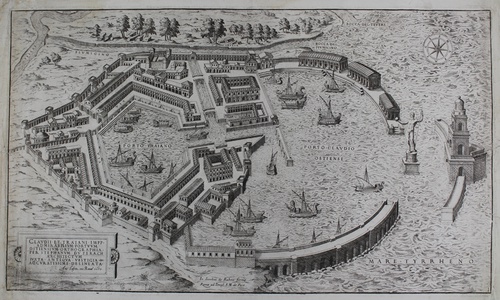| Method | Copper engraved |
| Artist | Lafreri, Antonio |
| Published | Ant. Lafreri exc. Roma 1575. Io. Iacobus de Rubeis fromis Romae ad. Templ. S.M. de Pace. [Rome, c.1650] |
| Dimensions | 405 x 695 mm |
| Notes |
A very rare, large, and impressive birds-eye perspective of the ancient Imperial Roman port of Portus, originally engraved by Antonio Lafreri in 1575 for his Speculum Romanae Magnificentiae. The Speculum Romanae Magnificentiae was a landmark publication, drawing together over two hundred views of Roman buildings, structures, and architectural and artistic details. The series was popular with sixteenth and seventeenth century cognoscenti, and because most editions were printed at the demand of the client, there was significant variation. Following Lafreri's death, the plates were dispersed, and continued to be be printed by a number of publishers, with each adding or subtracting views as desired. This particular example was printed by Giovanni Giacomo de' Rossi. Lafreri's view of Portus is almost identical to the fresco of the city which, along with numerous other Italian maps and city views, was executed by Ignazio Danti for the Vatican Map Gallery in the early 1580s. It is highly likely that Lafreri's engraving was the inspiration for the wall-painting. The plan shows the harbour from the North, in a style which is clearly modelled upon representations of the port on Roman imperial coinage. The distinctive harbour walls and lighthouse can be seen to the right, behind a colossal statue, likely a heroic representation of the emperor Trajan. The space enclosed by the harbour's walls, the original section of the Claudian building program, is filled with ships. To the left of this, the hexagonal extension built by Trajan can be seen. The arx (citadel) and temple of Portunus are also depicted and labelled, along with the Portus aqueduct and the branch of the Tiber that connected the port with the river. Portus, the Latin word for harbour, was an artificial port constructed by the emperor Claudius to alleviate some of the strain placed on the old Republic port at Ostia. The size and population of the city of Rome had expanded dramatically during the early Imperial period, such that the quantity of supplies required by the city had outgrown the capacity of the natural harbour at the mouth of the Tiber river. Claudius' original building project involved the construction of two long curving sea-walls to create a large artificial harbour. In the space between the walls, a lighthouse was constructed on a island created by sinking a large Roman barge filled with earth and concrete. In AD 103, the harbour was again expanded, under the orders of Trajan, by excavating a secondary harbour behind the original one and reworking the system of canals built to connect the harbour to the Tiber River. The town of Portus was also enlarged at this time, with monumental storage sheds constructed to manage the supply of grain to the Roman capital. Antonio Lafreri (c.1512-1577) was a French mapmaker, printseller, publisher, and geographer, and arguably the most important figure in Italian cartography during the sixteenth century. Having moved to Rome in the 1540s, Lafreri pioneered the publication of composite atlases (now colloquially referred to as 'Lafreri Atlases'), created and printed on demand for clients and drawing from a large selection of maps by various engravers. Lafreri himself was also a prolific engraver, and his views of Rome, published as the Speculum Romanae Magnificentiae, continued in publication for more than a century after his death. Giovanni Giacomo de' Rossi (1627-1691) was an Italian engraver, publisher, and author. A scion of the prominent Rossi family of publishers, he was the elder son of the printwork's founder Guiseppe de' Rossi, who opened his printery in 1633 near the church of Santa Maria della Pace. Giovanni, like other members of his family, not only produced his own plates, but also printed a wide array of works by other Italian printmakers and cartographers. Under Giovanni Giacomo and his son Domenico, the workshop reached its zenith, with father and son working on engravings on many diverse subjects, but with a speciality in publishing works of antiquarian interest. Following Domenico's death, the Rossi printshop became the Calcographia Camerale, then the Regia Calcographia, and finally the current Calcographia Nazionale. Condition: Central vertical fold, as issued. Repaired tears, creases, and surface dirt to edges of sheet. |
| Framing | unmounted |
| Price | £980.00 |
| Stock ID | 48644 |

